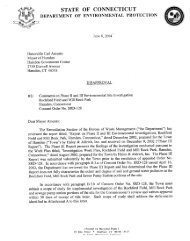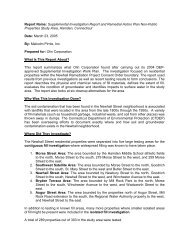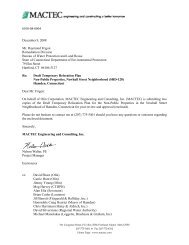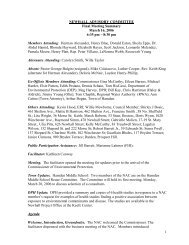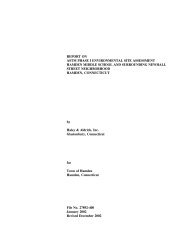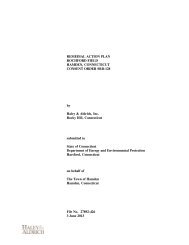Main Report - Newhall Remediation Project
Main Report - Newhall Remediation Project
Main Report - Newhall Remediation Project
- No tags were found...
You also want an ePaper? Increase the reach of your titles
YUMPU automatically turns print PDFs into web optimized ePapers that Google loves.
For our calculations, we assumed that a child spends 100% of their playtime in their yard (asopposed to playtime spent elsewhere, such as at a park). That child might have an incrementalblood lead level of 80 µg/dL (microgram per deciliter), estimated from the average (11,800mg/kg) lead concentration in soil. If the children spend only 50% of their playtime in their yard,CT DPH then estimates a potential incremental blood lead level of 40 µg/dL for those children,using the average concentration in the most contaminated yard. CT DPH believes it is reasonableto assume that children would not spend less than 50% of their playtime in their yards.These blood lead estimates are greater than the level of concern for potential adverse healthimpacts in children (greater than 10 µg/dL). It is important to note that 11,800 mg/kg is theaverage lead level in the most contaminated yard. 7 Estimated blood lead levels would be lower inyards with lower lead levels in soil. For example, using the ATSDR screening procedure, anyyard with an average soil lead concentration exceeding 1,500 mg/kg has the potential to result inblood lead levels greater than the level of concern for children (>10 µg/dL). This assumes thatthe child spends 100% of his or her play time in their yard. Average lead levels in several yardsexceeded 1,500 mg/kg, but they have already been cleaned up by EPA (as has the yard with anaverage lead level of 11,800 mg/kg). Therefore, under current conditions, there is no opportunityfor exposure to lead at levels of public health concern.Table 4. Estimated Blood Lead Increment from Exposure to Lead in Residential Soil,<strong>Newhall</strong> Street Neighborhood, Hamden, Connecticut (using ATSDR’s ScreeningProcedure, July 1999).ExposedPersonSoil LeadConcentration *(mg/kg)Soil Slope Factor(µg/dL blood leadper mg/kg soil lead)Fraction of play orwork time spent inone's own yardEstimatedIncremental BloodLead Burden (µg/dL)Child 11,800 0.0068 1.0 (100%) 80Child 11,800 0.0068 0.5 (50%) 40Adult 11,800 0.001 0.5 (50%) 6* The soil lead concentration of 11,800 mg/kg is the average concentration in the most contaminated yard. The average wasconservatively estimated as the 95% upper confidence limit of the average. It is unlikely to underestimate the true average.CT DPH’s blood lead calculations show that estimates of incremental blood lead levels inchildren are above levels of concern for potential adverse health impacts (>10 µg/dL). However,there is no indication that children living in the neighborhood actually have these levels of leadin their blood. The model used by CT DPH is a screening procedure that cannot predict the trueblood lead levels in any given person because of the many uncertainties inherent in therelationship between soil lead and blood lead. 8 At best, the model results indicate that at themost contaminated properties, there is the potential for increases in blood lead levels in children.At properties with lower lead levels in soil, the potential for exposure would be less. Fortunately,the homes with the highest levels of lead in surface soil that we know about, received immediate7 This yard (as well as other yards with very high lead levels) has already been cleaned up. 8 If someone is concerned that they might have elevated lead levels in their blood, they should contact their physician to get a blood test for lead. 18



